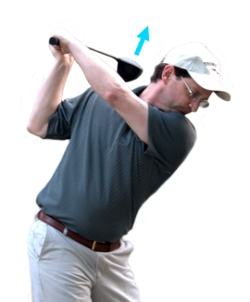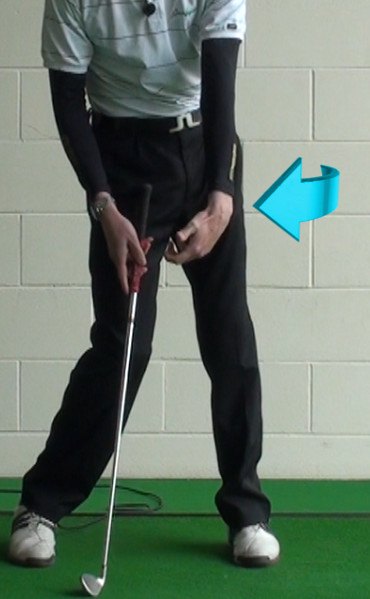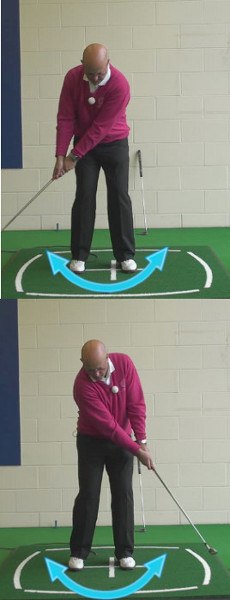
With five PGA Tour wins and a few near-misses in majors, Dustin Johnson is a household name among golf fans. He stands 6'4” and generates massive drives thanks to his exceptional athleticism; Johnson can dunk a basketball with ease.
He's also the subject of intense swing analysis thanks to his unusual hand position, which most golfers would find nearly impossible to emulate.
Unconventional move: Left wrist in an exaggerated "bowed" position and clubface closed at the top of the backswing
Who else does it:
Graeme McDowell, Lee Trevino, Arnold Palmer

Photo 1: The typical pro golfer's left wrist is flat (directly in line with the back of the forearm) at the top, setting the clubface square to the swing plane. Johnson's left wrist is severely angled, or bowed, and his clubface pointing skyward (closed).
Why it's a problem for amateurs: First of all, few golfers of any caliber could achieve Johnson's position if they tried. (In fact, the golfer pictured tried pretty hard, and still couldn't recreate this angle.) Johnson's wrists are remarkably strong and supple.
Bowed wrist or not, it's the closed clubface that causes fits for lesser players. From here, hooks of varying degrees are practically guaranteed.
How Johnson gets away with it: Like great athletes in other sports, Johnson compensates for a technical flaw with raw ability. His enormous lower body rotation on the downswing, driven by his right side, creates space for the wrists to unwind. By impact, his hands are ahead of the ball and the clubface square. Johnson somehow manages to hit high fades when mortals would produce nothing but hooks with his backswing.
The cure: If you suffer from a shut clubface at the top, the fix actually lies at the bottom of your swing. On the takeaway, drag the club back using the arms and shoulders, without consciously hinging the wrists. Stop when the hands reach hip height and the shaft is parallel to the ground – the toe should point straight up. If it points in front of you, the face is closed, meaning you've under-rotated the forearms.
Work on getting to this point in the toe-up position without manipulating the clubs with your hands. Natural forearm rotation should do the trick. If it doesn't, a grip change may be in order. A grip that's too weak (hands turned to the left as you look down) or too strong (hands turned right) can cause a closed clubface. Adjust yours accordingly.

Dustin Johnson's Bowed Left Wrist
By any measure, Dustin Johnson is one of the very best golfers in the world. While he is yet to claim his first career major championship after a number of close calls, Johnson has been a consistent winner and contender throughout his time on Tour. One of the longest hitters in the game, Johnson is a fan favorite thanks to his impressive power and laidback demeanor. There are some people who don't feel like professional golfers really belong in the category of 'athletes' – but those people probably haven't taken a good look at Dustin Johnson on the course. He is very much an athlete in every sense of the word, and it is always exciting to see what he can do to long and challenging golf courses.
When you watch Johnson make his powerful swing, one thing stands out right away – the unique position of his left wrist at the top of the backswing. Most good players have the left wrist in a flat position at the top, and some even have the wrist cupped slightly to promote a fade. However, that story is completely different with Johnson, who has his wrist dramatically bowed outward when he gets to the transition. The bowed wrist at the top causes the club face to be in a closed or 'shut' position while he transitions from backswing to downswing, but it is a style that obviously works perfectly for him.
For most players, using a bowed left wrist and a shut club face is not going to be a recipe for success. It is easier, and usually more consistent, to simply do your best to keep the club face square to the path for as long as possible during the swing. Anytime you get the face pointed in a different direction than the one it will need to point in at impact, you are going to have to do some degree of recovery on the way down. Obviously, Dustin Johnson is able to make this unique position work for him, but that doesn't mean that it will work the same for you.
With that said, there is something to be learned from every swing, and that certainly applies in this case. Any time a player has the degree of success that has been experienced by Dustin Johnson in his career – and anytime a player can blast the ball as far as Johnson can – it only makes sense to take a closer look. What is it about this swing that has led to such great success? Are there any parts of this swing that you can copy for yourself? Improving in golf is all about continuously learning more about the game and more about your own swing – and watching the best players in the world do what they do will give you a great jump start toward those goals.
All of the instruction below is based on a right handed golfer. If you happen to play left handed, please reverse the directions as necessary.

How Does It Work?
When you see Dustin Johnson make a swing, you naturally expect the ball to quickly hook to the left. After all, swinging with a shut club face at the top frequently leads to a hook, at least it does in the amateur world. However, you will rarely see Johnson hit a quick hook. Most of the time, he simply rips the ball right down the middle of the fairway. His ball striking is on an elite level that can be matched by few in the game. So, how does he manage such incredible ball striking while playing from such a unique position at the top? It all starts with excellent body rotation.
The key to the success of Dustin Johnson's golf swing all comes down to his ability to turn through the ball. The only reason Johnson doesn't flip the ball left time after time is the fact that he clears his hips so well on the way down. If you take a look at a slow motion recording of his swing, you will see that his body is turning past the ball while the club is still hanging back high in the downswing. It is the separation between his upper body and lower body on the way down that allows him to create such impressive power while still hitting the ball straight time after time.
While the golf swing is an endlessly complicated thing, you can understand Johnson's swing simply by understanding how well he turns both back and through. The big shoulder turn he makes going away from the target enables him to store up power, and he then unleashes that power by turning just as aggressively through the ball on the way down. You probably already knew that a great shoulder turn and hip rotation was key to hitting powerful shots, but Johnson is a great visual representation of that concept.
Of course, you can't just copy the way Dustin Johnson turns through the ball and expect to see great results. Johnson is a great athlete who possesses above average height, flexibility, and strength. Unless you have all of those same qualities, the method he uses for swinging the club is unlikely to be successful for you. It can be beneficial for your own game to make an effort to improve your body rotation – especially on the way down toward impact – but attempting to directly copy Johnson's technique into your own game is a plan that is destined to fail.
Watching Dustin Johnson hit shots is a good reminder of what is so great about the game of golf. Would any golf instructor teach a young student to swing the way that Johnson swings? No, probably not. It is too unusual, too unorthodox, and too difficult to repeat. However, Johnson has made an incredible career (and millions of dollars) based on that very swing. In a day and age where it seems that all golfers are trying to replicate the same pattern that is generated from a computer when it comes to swing technique, it is nice to see that there is still room for personal style and athleticism in the game. Dustin Johnson doesn't make a swing that is copied right out of a computer, and he has been rewarded with an impressive career.
The lesson here is obvious for the average golfer – don't feel pressured to swing the club in any particular way. If your swing is a little bit 'different' from many others, that's okay. In fact, it very well may be a good thing. The only thing you need to worry about is getting the ball into the fairway, onto the green, and into the hole. Everything else is just noise. If your swing works from a results stand point, it should be considered a success. Never be afraid to be yourself on the course, and use the techniques and methods that work for you. It is always possible to add new elements to your swing in order to improve, but never lose track of who you are in the process.

Making a Great Turn
Most likely, you aren't going to play with your wrist in a bowed position at the top of your swing. However, that doesn't mean that you can't learn from Dustin Johnson in terms of how he uses his entire body to his powerful shots. The majority of amateur golfers fail to use their bodies efficiently during the swing, which is why they rarely can hit the ball as far as their professional counterparts. If you would like to add distance to your ball striking ability within making many dramatic changes to your swing, improving your turn is one of the best things you can do.
The following tips will help you make a better turn both back and through the shot.
- Freedom in the right knee. This is somewhat of a tricky point, because you want to allow your right knee some freedom of movement in order to maximize your shoulder turn going back – but you don't want your lower body to get out of control at the same time. If you watch Johnson's swing, you will see that his right leg straightens considerably during the backswing, which helps him make a great shoulder turn. However, he doesn't allow that right knee to slide to the right and away from the target, which would hurt his balance and cause other problems. So, as you swing back, remember that it is okay to let that right leg straighten up some as long as it isn't sliding away from the target.
- Proper stance. Dustin Johnson uses a beautifully athletic stance when he gets over the ball at address, and you should aim for the same kind of position in your own game. Keep your back straight, place some flex in your knees, and make sure your chin is up away from your chest. As long as you are able to hit on these three basic points, you should find your body in a great position while standing over the ball. With a good stance on your side, it will be much easier to rotate away from the target, and that improved rotation is almost sure to lead to better ball striking.
- Even tempo. Rushing through the swing is a sure way to wind up with a short body rotation. You need to give yourself time to turn back and through, so maintain an even tempo in your swing and don't allow yourself to get in a hurry. Remember, the ball isn't going anywhere, so you have as much time as you need to load up and strike the shot. During your practice sessions, make it a priority to work on an even tempo and then do your best to carry that rhythm with you onto the golf course.
- Extension in the arms. To pull yourself around, especially in the backswing, you want to make sure that you have great extension in your swing from start to finish. That means that you don't want to allow your arms to get pulled in tight to your body early on in the takeaway – a mistake that is made by many players. Keep your left arm extended as you swing back and allow your shoulder turn to gradually move the club up into position. Maintaining good extension going back will serve to help your turn, and it will also make it easier for you to avoid the slice.
There are very few things you can do in the swing that are as important as making a great turn. When you are able to turn nicely going back and aggressively moving forward, you will be capable of hitting powerful shots time after time. Most amateur players never manage to make a great turn, which is why they struggle with shots that travel a short distance and frequently miss to the right. To play more like a pro and less like an amateur in your upcoming rounds, work hard on improving your turn.

Confidence Moving Forward
A big part of having success on the golf course comes down to confidence. If you lack confidence in the quality of your swing, it will always be difficult to produce good shots. On the other hand, if you believe in yourself completely, you can actually overcome some technical flaws in your swing on your way to posting good scores. Professional golfers don't always make perfect swings, but they have a high level of confidence and they believe that they are capable of getting the job done.
There is no point during the swing where confidence is more important than on the way down toward impact. You cannot afford to hesitate during your downswing, as even a momentary pause can cause your shot to go wildly off track. When Dustin Johnson swings down into the ball, for example, you can almost see the confidence coming out of him – he is sure that the ball is going to head directly to the target. He is able to turn so aggressively (and so quickly) in large part because he is confident in his swing and his abilities. Are you that confident when you swing down toward impact? Probably not – and the results of your shots likely prove that point.
The best way to build confidence in your swing is to work on your technique on the driving range. There should be no nerves to deal with on the range, so you don't have to worry about doubting yourself at any point. You are free to make the best swing that you can – and you can always load up another ball if the previous shot didn't meet your expectations. It is only after you have hit shot after shot with good results on the range that you will start to build up confidence in your swing that you can take with you out onto the course. The golf course has a powerful way of eating away at hard-earned confidence, so you have to make sure you are ready for that test before making your next tee time.
By taking the time on the range to refine your technique and get your body into the right position, you will have a reason to be confident on the course. Many players know that they need to have confidence, but they aren't willing to do the work required to actually earn that confidence. You can be sure that Dustin Johnson is putting in countless hours of work on the driving range (and in the gym) in order to prepare his swing for the biggest golf tournaments in the world. While you aren't going to have the same amount of time to dedicate to your game, you can still take steps in the right direction by heading to the range as frequently as possible. Golf is a hard game, so the only way to build confidence is through hard work and dedication – the same formula that is required for success in any part of life.

Wrist Position in the Short Game
Generally speaking, the short game is a totally different animal as compared to the long game. Your full swing is complicated, demanding, and difficult to repeat on a consistent basis. On the other hand, the short game motions you need as a golfer (putting stroke, chipping swing, etc.) are relatively simple and straightforward. They aren't always easy to execute, especially under pressure, but nothing about your short game technique needs to be complicated.
The left wrist plays a big role in your short game just as it does in your full swing. Since the position of your left wrist usually mimics the position of the club face, you can use it as a guide to make sure that you are on track to hit a good shot. So, do you want to bow your left wrist outward while hitting short game shots? No, probably not. Ideally, you will be able to keep this wrist as flat as possible through the hitting area, as that method will help you keep the club face pointed directly at the target. In Dustin Johnson's full swing, he is able to turn aggressively through the ball in order to hold the club face square to the line, but that isn't an option in the short game. Rather, you want to keep the face square from start to finish in these short shots so that no last-second adjustments are required.
When putting, the idea is to set your wrist in a good position at address and then hold it still throughout the rest of the stroke. You shouldn't be moving your hands or wrists at all during a putting stroke – the motion is controlled by simply rocking the shoulders. The back of your left wrist should be pointing toward the target line that you have picked out and it should continue in that direction as you swing forward through the putt. While you can use your left wrist position to help you form a good grip on the putter at address, you typically aren't going to need to think about your wrists while putting – and that is a good thing.
The story is a little different when it comes to chipping. Your hands and wrists will need to get into the action while chipping, so make sure to consider the position of your left wrist as part of the equation. This is one time, in fact, when you might want to move into a slightly bowed position (although not as dramatic as the position Dustin Johnson uses in his full swing). As you set up to your chip shots, you likely want to position your left wrist similarly to how you have it positioned when putting, with the back of the wrist pointing at the target. However, when you start the chipping action, you can go ahead and hinge your wrists slightly in order to create some downward angle to use in the forward swing.
Some players will feel most comfortable chipping with the back of their wrist flat, while others will like the way it feels to bow it out slightly during the swing. Either way can be effective, as long as you avoid cupping your wrist at any point. Cupping the wrist is the opposite of bowing it out, and this move will add loft to the club (and expose the leading edge to the ball, making a thin shot a possibility). So, while chipping, make sure you are staying somewhere from flat to bowed with the left wrist, and your short game will improve as a result.
Dustin Johnson remains one of the best players in the world today, and he will likely hold that title for a long time to come. It would surprise no one if Johnson were to one day claim a major title, and he might even have more than one before his career is finished. While you probably don't want to copy the bowed wrist position that Johnson uses to launch powerful shots down the fairway, there is plenty you can learn from his game as a whole.






